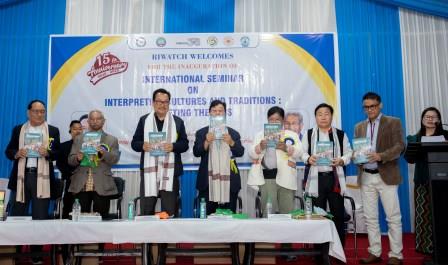Latest News
-
BJP sweeps IMC elections; PPA aces PMC polls
-
 Governor attends Himalayan University Convocation
Governor attends Himalayan University Convocation
-
 Book on Traditional Festivals of Arunachal Pradesh released
Book on Traditional Festivals of Arunachal Pradesh released
-
Workshop on GIS and Remote Sensing
-
‘Yogananda Bhavan’ inaugurated at Ramakrishna Mission Narottam Nagar
-
Arunachal to participate in 9th Federation Cup Wushu Championship
-
East Siang conducts mock counting for Panchayat & PMC…
-
Lohit takes governance to doorsteps with ‘Prashasan Gaon Ki Aur’…
-
Buddhist community rallies for repealing Bodh Gaya Temple Act…
-
Lower Subansiri reviews preparedness for counting day
4th Dec 2018 10:12:PM Editorials
What has been happening to Siang River, the strange characteristic changes witnessed in the past, is due to increased damming activity on Yarlung Tsangpo (River Siang or Brahmaputra) in the Tibetan Plateau. The Tibetan Plateau is the world’s largest freshwater repository and the source of Asia’s greatest rivers, including those that are the lifeblood of mainland China, South Asia and Southeast Asia. On the Brahmaputra, it is currently constructing several more. Its dam-building is slowly and secretly moving gradually to Tibet’s water-rich border with Arunachal as the Brahmaputra makes a U-turn to enter India. By building an array of new dams on rivers flowing to other countries, Beijing seems set to roil inter-riparian relations in Asia, and make it more difficult to establish rules-based water cooperation and sharing, say reports emerging from concerned quarters.
China has also emerged as the key impediment to building institutionalised collaboration in Asia on shared water resources. In contrast to the bilateral water treaties between many of its neighbours, China rejects the concept of a water-sharing arrangement or joint, rules-based management of common resources. The long-term implications of China’s dam programme for India are particularly stark, because several major rivers flow south from the Tibetan plateau through Arunachal Pradesh to Assam. The Siang River has witnessed major turbulence this year due to China’s damming activities close to India’s border. China’s dam programme on international rivers is following a well-established pattern: build modest-size dams on a river’s uppermost difficult reaches, construct larger dams in the upper-middle sections as the river picks up greater water volume and momentum, before embarking on mega-dams in the border area facing the neighbouring country. The cascade of mega-dams on the Mekong River, for example, is located in the area just before the river enters continental Southeast Asia, say experts and people in the know of things.
India has water-sharing treaties with both the countries located downstream from it: the Indus pact with Pakistan guarantees the world’s largest cross-border flows under any treaty regime, while the Ganges accord has set a new principle in international water law by granting Bangladesh an equal share of downriver flows in the dry season. China, by contrast, does not have a single water-sharing treaty with any of its neighbours. What is more important to note is that many of China’s new dam projects are concentrated in the seismically active areas, covering parts of the Tibetan Plateau. Alarm bells should ring now as a Bangalore based organization studying seismology in the Himalayas has now predicted an impending big earth quake above 8 on Richter Scale.

Kenter Joya Riba
(Managing Editor)She is a graduate in Science with post graduation in Sociology from University of Pune. She has been in the media industry for nearly a decade. Before turning to print business, she has been associated with radio and television.
Email: kenterjoyaz@easternsentinel.in / editoreasternsentinel@gmail.com
Phone: 0360-2212313

